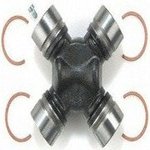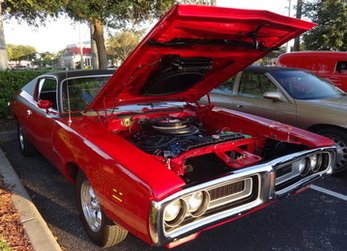
It’s most common to find drive-shaft u-joints on rear wheel drive automobiles. You may also find them driving the front wheels on 4×4 trucks and some all wheel drive car models.
Ford liked to use them on older trucks and sport utility vehicles with I beam suspension. Often this flexible joint will have a grease fitting located near the center cross.
If you have one, it will need regular lubrication maintenance. Sometimes a 90 degree adapter for your grease gun is needed to pump in the lubricant. In other cases they’re sealed from the factory and will require no regular servicing at all.Drive-shaft u-joints have been around for a long time. In fact, I became familiar with these parts at a young age when I got my learners permit and began driving. My first car was a 1974 Dodge Charger.

I made the classic mistake of putting a shackle bar lift kit above the rear leaf springs.
I did this so I could install a pair of giant L60 tires and deep dish Craiger wheels on the back. All the kids were doing it at the time. It wasn’t long after these alterations that the mighty Dodge began to have problems with the rear universal joint.
I didn’t realize my modification drastically changed the angle the drive-shaft operated at. When I raised the body it lifted the transmission, but the rear differential carrier stayed in the same spot. The new angle on the old part, coupled with aggressive hot rod driving habits, destroyed it quickly.
Symptoms of a Bad Universal Joint
One of the most common symptoms of developing u-joint problems is hearing a clunk while shifting the transmission into gear. A badly damaged universal joint will make a racket when moving the shifter from reverse to drive.
Although this clunk can be caused by other problems it may be a sign of excessive clearance in the u-joints. When a drive shaft flexible joint is on its way out it might make a squeak sound at lower speeds.
It can also cause vibrations at higher speeds. This may feel like a wheel balance problem. The way to tell the two problems apart is in most cases a worn u-joint will cause vibration during acceleration or deceleration. A tire balance problem will create a steady vibration regardless of throttle position.
Diagnosing Failed Drive Shaft Components
A road test is just the first step in confirming a problem with the drive-shaft. It’s easier to examine the parts with the vehicle up on a lift. When you inspect the universal, if you see grease leaking out of the end caps, it’s a sure sign of a problem.With the vehicle raised in the air and the transmission placed in neutral you can usually grab the drive shaft and rotate it to spin the rear wheels. Moving it a half turns up and back in either direction is a good way to inspect for looseness or free play. It should have no noticeable play when moving up and back as described.
Removing and Inspecting the Drive-shaft
Before you remove the drive-shaft it’s a good idea to mark it in relationship to the differential yoke.
In some cases a shaft can be specifically balanced. If you remove and reinstall it and a vibration that wasn’t there before surfaces it might be out of phase.
When the propeller shaft, as the British call it, is removed it’s easier to check the condition of the universal joints on both ends of the propeller shaft.
You should be able to rock the flexible joint in all directions and it should provide smooth steady movement. Any stiffness or bumping that’s felt is a sure sign of a defective u-joint.
Although it’s not a common problem, repeat universal joint failures can happen. I’ve seen some weird things cause stubborn vibration complaints from drivers. More then once the root cause was undercoating installed on the vehicle.
A sloppy undercoat job can get on the drive-shaft itself and cause out of balance problems that can have negative effects on longevity. If you find u-joints with any problems, just go ahead and replace it.
In most cases they are not expensive. Different manufacturers have different types of joints. Therefore, they have different service procedures for replacing defective parts.Example, the General Motors original universal joints use plastic inserts to lock them in place. These can be difficult to replace. The Ford universal joints with removable spring lock clips are much easier. I recommend that you check your online auto service manual for the specific procedure on your automobile.
Do you want to run a drive shaft problem past a mechanic? Visit the auto repair help page for more information on this available service.
There is not a lot of information on the internet in regards to drive trains. This is why I decided to dedicate a repair module to the manual drive trains subject.
I also put together a couple of pages for front wheel drive-shaft u-joints better known as (CV) constant velocity joints.
Get a rundown on the kind of information that’s available here at the you fix cars website. Visit the homepage and learn more about Diy auto repair.

